On View
How to Look at a Sam Gilliam Painting: With One Eye on History and the Other on Color and Form
Dia:Beacon has added Gilliam's "Double Merge" to its permanent display.
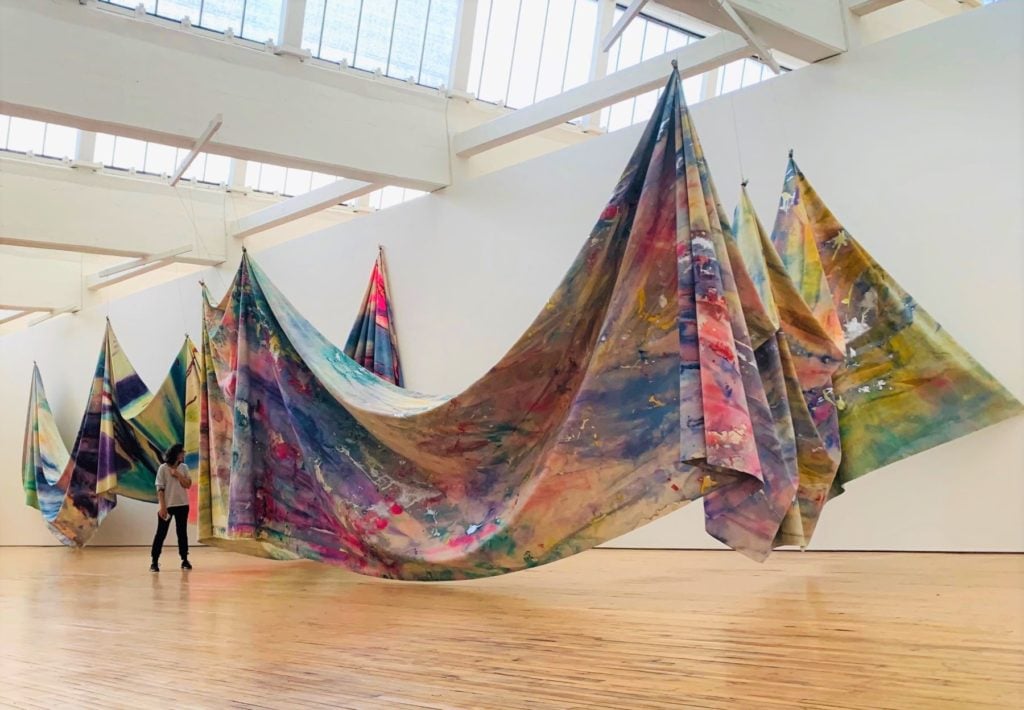
Dia:Beacon has added Gilliam's "Double Merge" to its permanent display.

Ben Davis

Here’s an old question that I find is still alive for a lot of people: How do you look at an abstract painting? Are you meant to just immerse yourself in the wordless presence of its colors? Or does it tell a kind of story too—about its author’s ambitions, about its place in art history, about ideas of painting itself—that you are meant to enter into as well? How does it speak to you?
Sam Gilliam is certainly an artist who lends himself to wordless immersion. Now in his late 80s, the artist has a storied history, becoming the first African-American artist to represent the US at the Venice Biennale, in 1972, and winning the Presidential Medal of Arts in 2015. But he has been having a major moment lately, and if you’d like to contemplate why, Dia:Beacon has just unveiled a permanent gallery dedicated to him at its upstate temple of Minimalism. Its centerpiece is the ambitious, gallery-swallowing Double Merge (1968).
This is one of the first of Gilliam’s signature “Drape” paintings—abstract painted panels that are then loosely hung from the wall, often at ambitious scales. Above all, these are lovely choreographies of paint and canvas, impressive presences. Double Merge is almost nostalgic to me in its tonic faith in the direct pleasures of color.
But there’s also more to get out of it. In their deep structure, Gilliam’s works are animated by a story too. Their specific dynamism condenses something about the historical moment when Gilliam had his inspiration for them, the late ‘60s—exactly when people were asking more of abstraction.
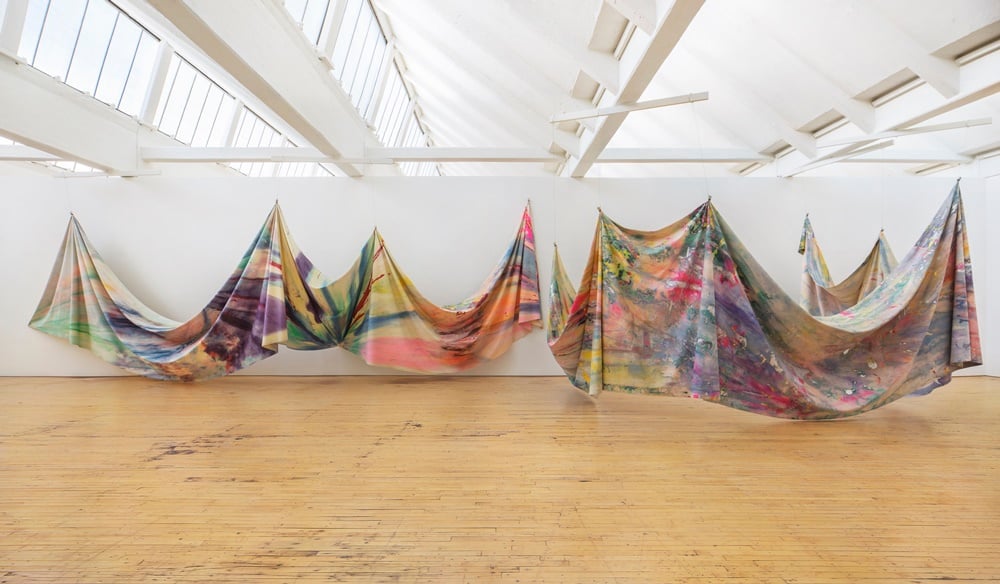
Sam Gilliam, Double Merge (1968). Installation view, Dia:Beacon, Beacon, New York. © Sam Gilliam. Photo: Bill Jacobson Studio, New York, courtesy Dia Art Foundation, New York
Double Merge consists of two large, loose canvas panels, one suspended at four points along the wall, the other suspended from six and made to bulge into the gallery as if creating an enclosure. In both, the fabric droops in a series of folds that nearly brush the floor, evoking kingly robes or theater curtains.
As for the surfaces, you see sweeps of thin lavender, green, pink, yellow, and sherbet orange, occasionally interrupted by a short, sharp ribbon of darker red or a splash of hard, metallic silver.
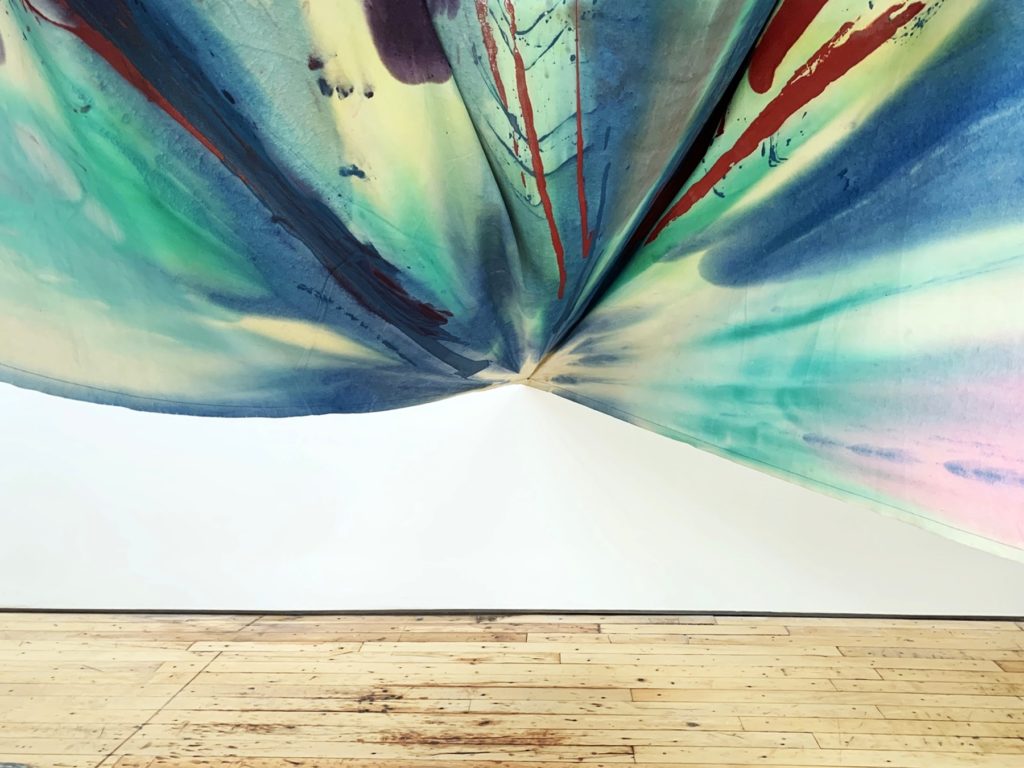
Detail of Sam Gilliam, Double Merge (1968). Image: Ben Davis.
Sometimes the way the fabric is gathered together seems to concentrate the patterns of paint into starbursts or explosions. Other times the folds in the draped canvas seem to cut against the sense of motion implied by the painting on its surface, bluntly counteracting any illusionary ethereal atmosphere with a reminder of real gravity, real mass.
These contrasts and tensions play out along the length of Double Merge at a beat-by-beat, foot-by-foot level. Gilliam has talked of adding the tension between sculptural and pictorial qualities to the familiar “push and pull” of color in traditional abstract painting (coming out of the pedagogy of Hans Hofmann).
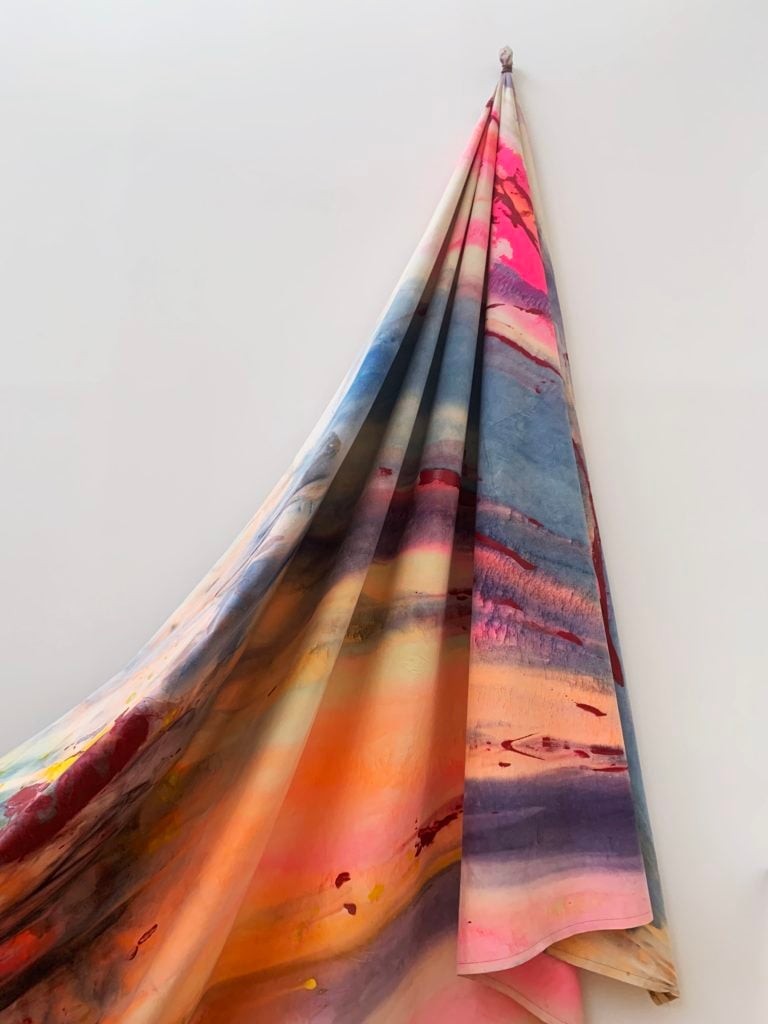
Detail of Sam Gilliam, Double Merge (1968). Image: Ben Davis.
In this, Gilliam was both logically developing and defying the values of the art around him at the time. Raised in Louisville, Gilliam would discover a calling in abstract painting circles in Washington, DC, inspired by the pleasing palettes and expansive surfaces of painters like Morris Louis and Kenneth Noland. Gilliam is known as a member of the Washington Color School, or sometimes as a “Third Generation” Color Field painter—which is to say that by the time he was trying to make his way, a long, heroic cycle of American abstract painting was in its late stages. Gilliam remembers that his mentors still taught art history as having a logical and natural progression: an artist’s job was to understand the direction of painting heretofore, and find the next natural move to play to be successful.
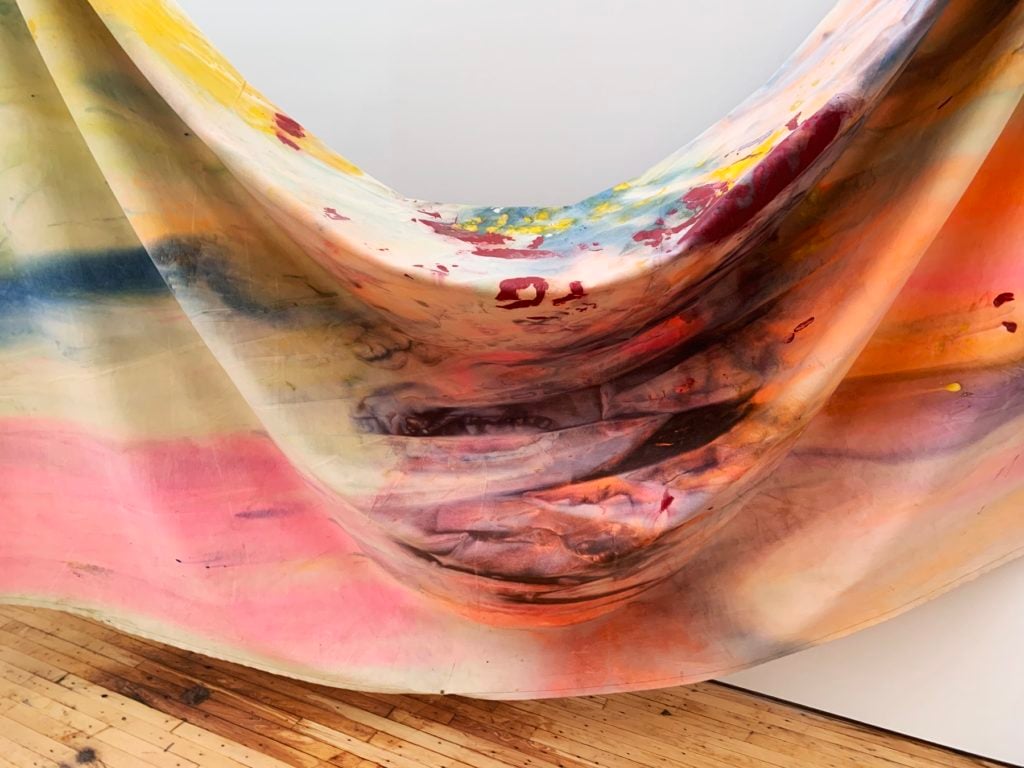
Detail of Sam Gilliam, Double Merge (1968). Image: Ben Davis.
But the ‘60s were unkind to genteel narratives of progress, including artistic progress, which came to seem unattuned to the gnarlier wavelengths of ascendant Baby Boomer taste. Pop Art and Conceptual art were both in different ways reactions to the previous dominance of Abstract Expressionism, with its lyrical and exalted sensibility. In their various ways, they brought in the everyday.
By the mid-‘60s, even the arch congregations of manufactured elements found in Minimalism—marked rejections of old-fashioned painterly attachments to composition and the “hand of the artist”—were giving birth to what would come to be called “Post-Minimalism”: all slouchy, perplexed surfaces and unconventional materials, the better to cypher the sense of chaos and disintegrative mental space of those socially turbulent times.
For that matter, the mid-‘60s transition from the Civil Rights to the Black Power period was making very clear demands on black artists like Gilliam for political content, and for disaffiliation from white power structures, of which abstract painting was sometimes thought to be one.
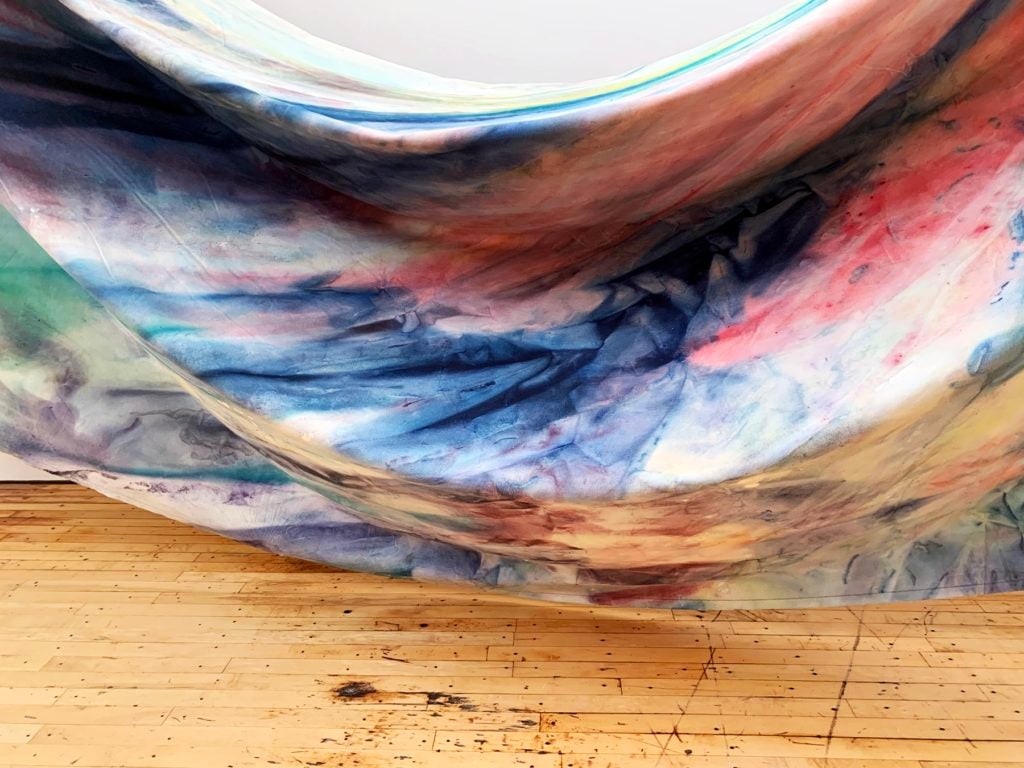
Detail of Sam Gilliam, Double Merge (1968). Image: Ben Davis.
Artistically, Gilliam was in DC, not in New York, which was the heart of the more overwrought and trend-setting stylistic debates. As for political subject matter, though he would make abstract works whose titles and atmosphere referenced the assassination of Martin Luther King, Jr., and the subsequent urban rebellions (e.g. April 4, Red April), he also cherished abstraction as a model of freedom.
Gilliam had already been working through various experimental techniques with canvas by the time he hit on his signature draping. Like a lot of my favorite art, his most famous invention, which he came upon in the seismic year of 1968, summons together all the background historical energy into a simple, potent device that serves as both method and metaphor.
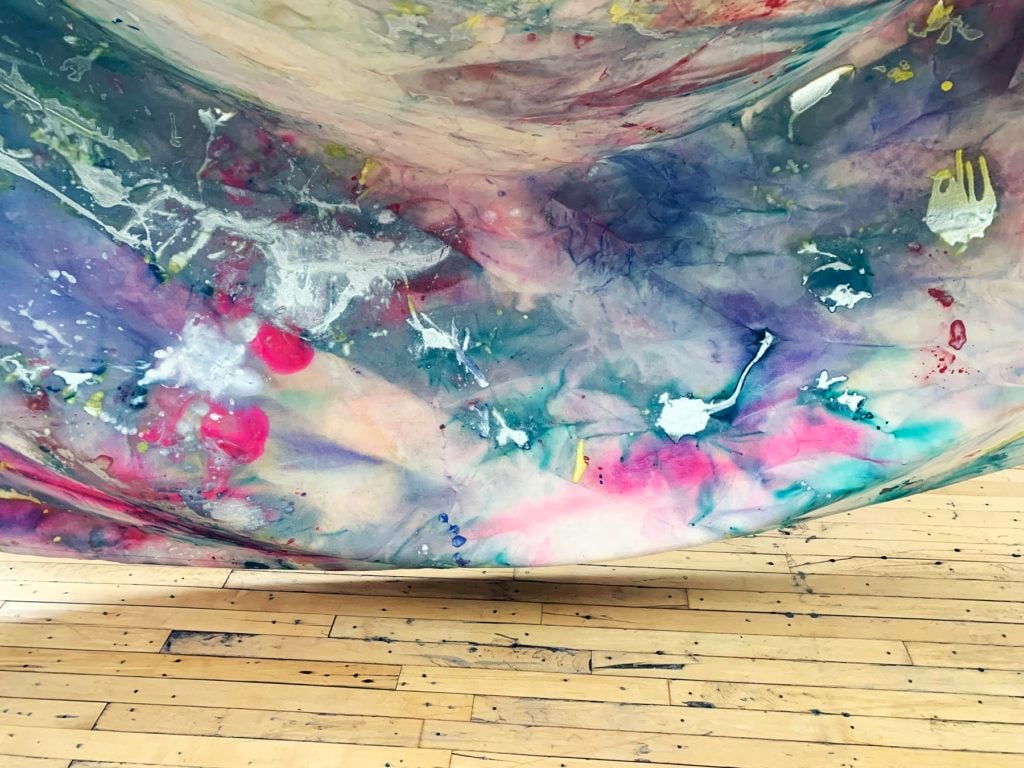
Detail of Sam Gilliam, Double Merge (1968). Image: Ben Davis.
In his interview with the Smithsonian Archives of American Art, along with such heroes of the day of the DC abstract painting scene as Howard Mehring and Tom Downing, Gilliam also mentions as an inspiration for his “Drapes”—unexpectedly to me—Robert Morris, the New York sculptor who bridged Minimalism, Conceptualism, and Post-Minimalism, known for his soft sculptures and heady polemics. The classic late defense of abstract painting, Michael Fried’s delightfully severe “Art and Objecthood” of 1967, had slammed Minimalism—and Robert Morris’s art specifically—for its “literalness,” its obsession with scale as a substitute for visual interest, and its lack of commitment to the construction of a final, achieved epiphanic image. This was a hot debate of the day.
Look at Double Merge and you can see that all those values that Fried is attacking as a threat to painting are exactly what Gilliam breezily incorporates into painting with his “Drapes.” He was inspired in making them, he says, by seeing clothes hanging on a line. That is, he very much meant to suggest the down-to-earth presence of objects in the world, resonating with the spaces of ordinary people: “what was most personal to me were the things I saw in my own environment,” he told Artnews. As for scale, freeing the painting from the stretcher would also allow Gilliam to embrace a new kind of vastness.
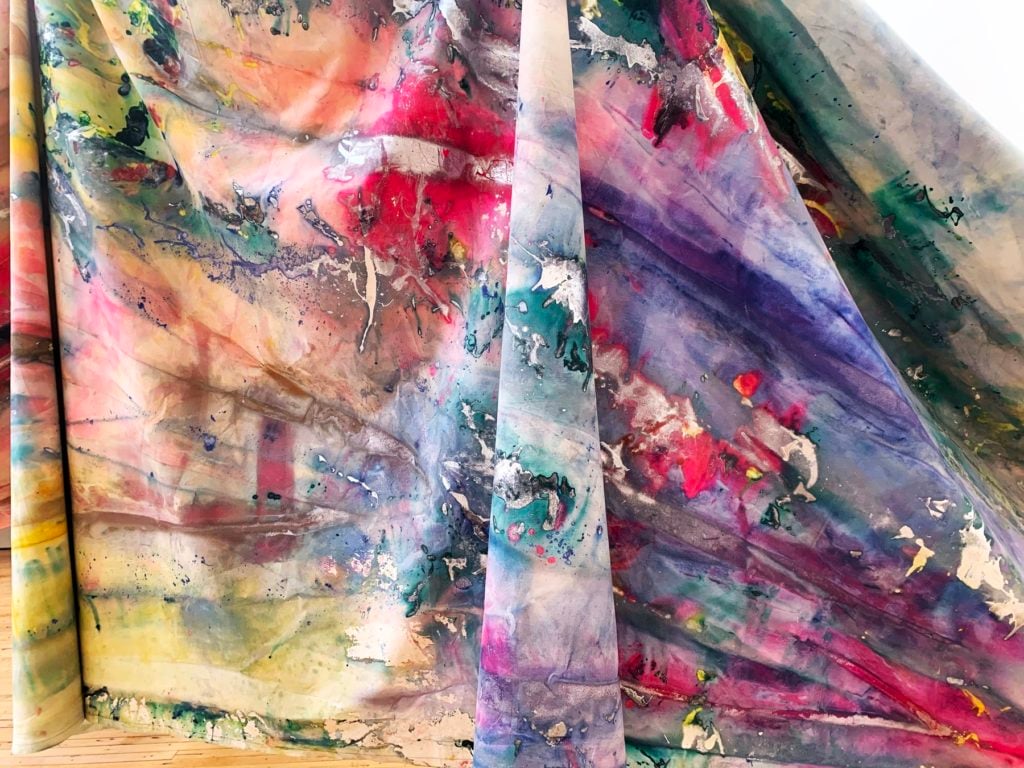
Detail of Sam Gilliam, Double Merge (1968). Image: Ben Davis.
Commitment to Fried’s treasured sense of painterly “presentness and instantaneousness” also went out the window in Gilliam’s “Drapes,” in an interesting way. An effect of working with loose canvas is to accent the break between the original act of coloring the surface and its final, draped form in the gallery. A deliberate, improvisatory lack of finality is coded into Gilliam’s “Drapes,” both in the work’s installation and in how you interpret what is going on when you are seeing it.
“How much serendipity is there in the way folds fall?”, an interviewer asked in 1972. “There’s a hell of a lot,” Gilliam replied.
And yet, if you go back and read Robert Morris’s 1966 “Notes on Sculpture,” it’s not just that that text doesn’t chime fully with Gilliam’s art, it’s almost as if Morris were directly writing against it: “the concerns of sculpture have been for some time not only distinct but hostile to those of painting,” Morris theorized. A little later, he continued: “The autonomous and literal nature of sculpture demands that it have its own, equally literal space—not a surface shared with painting.”
It was exactly a shared space of painting and sculpture that Gilliam embraced. And while Morris wrote, the same year as Double Merge, of embracing entropy and randomness as values in and of themselves, Gilliam’s process embraced such values at one level only to use them to find a fresh way to come back at ideas of composition and intention. While his draping suggests a certain (literal) taking painting down a peg and embrace of a certain “everyday-ness,” Gilliam still very much flaunts the stuff traditionally celebrated by painting: color and canvas.
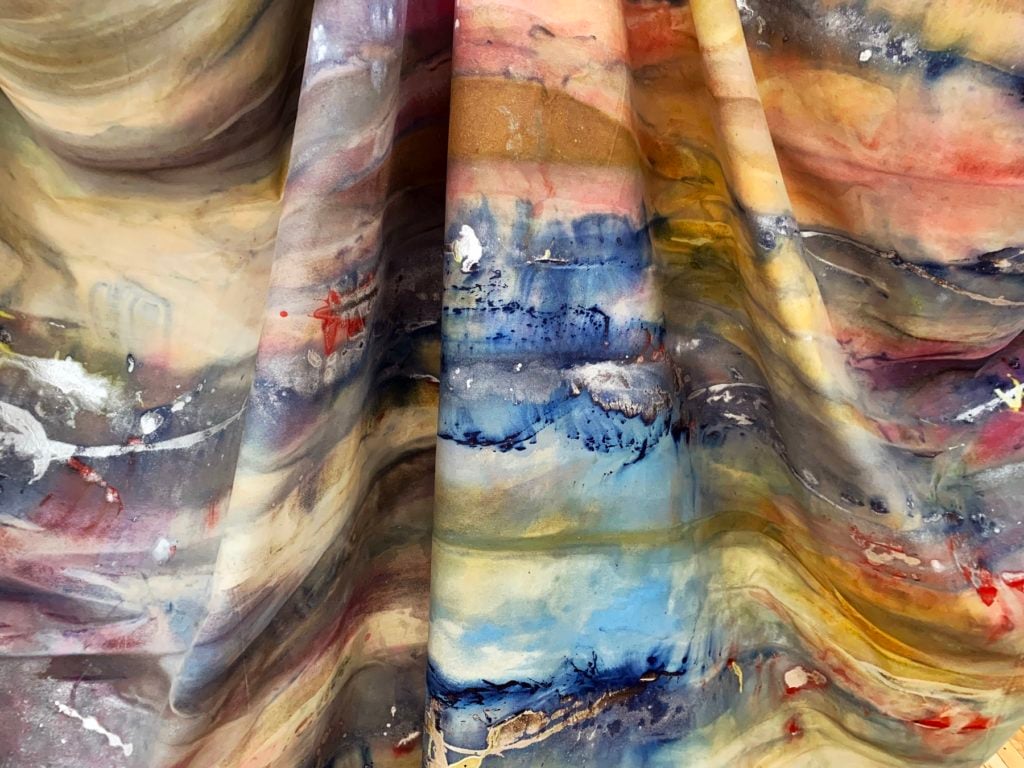
Detail of Sam Gilliam, Double Merge (1968). Image: Ben Davis.
And this brings us very specifically back to Double Merge, because here’s something very important about its contemporary incarnation at Dia: It is actually two works stuck together to form a new work (both were originally called Carousel II). That’s the “Merge” of the title.
What is the effect of this operation on you, as a viewer? At first you contemplate the whole thing as one big, bold installation. Then, very quickly, it asserts itself as not one, but two distinct parts. This division is not subtle, when you stay with the painting. One is hung close to the wall; the other comes out from it. Both are Gilliam “Drapes.” But they are marked as having their own logic.
At the level of their surfaces, too, the more you look, the more they distinguish themselves from each other within the common grammar of Gilliam’s overall technique. The composition of the left “Drape” is airier, more diaphanous. The surfaces of the right one are denser, punctuated with those blotches of industrial silver. The former much more evokes movement and atmosphere, the latter more a section of rainbow earth.
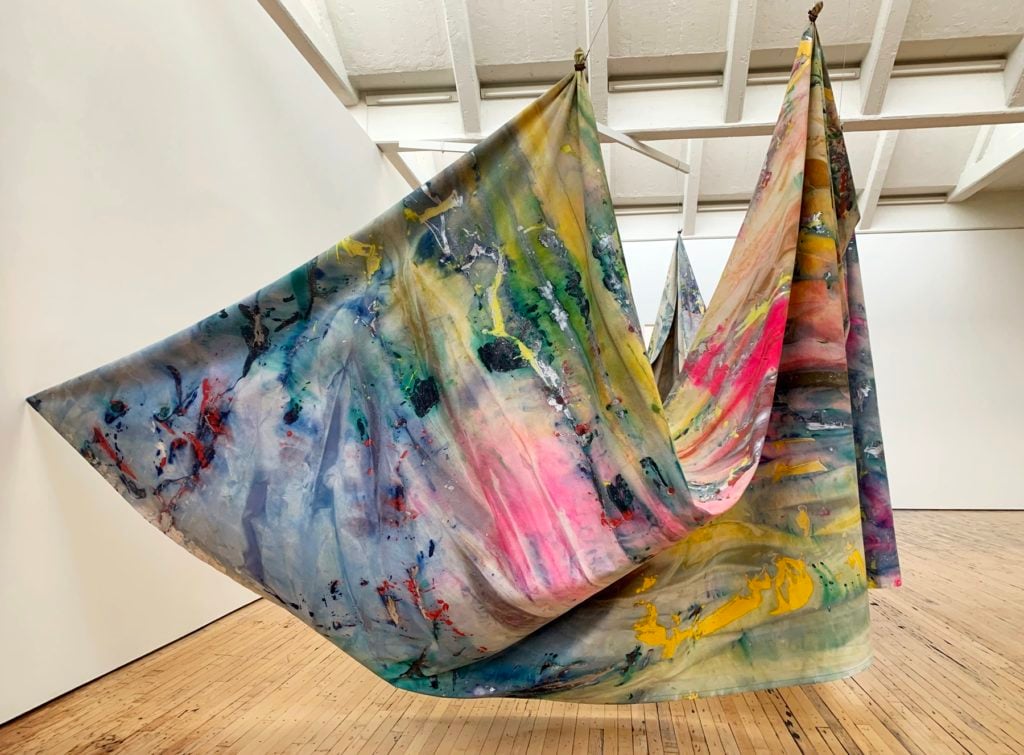
Installation view of Sam Gilliam, Double Merge (1968). Image: Ben Davis.
For me, the title Gilliam has given to this collocation evokes the idea of a “double negative.” The unique identities of Double Merge‘s two paintings are at first negated by putting them together; but then, at the next level, their merger also cancels this cancelling—the point of uniting them is the juxtaposition that allows individuality to emerge once more, to break through the mental cliché that this art is just colors and folds, randomly distributed.
In that, Gilliam’s work at Dia tells a story, via painting, of a specific historic trajectory that he has inhabited, looking deep into the surrounding entropy that seemed to be canceling out the world he loved, passing through it, and returning to a faith in seeing things fresh. It’s a remarkably tough and subtle kind of beauty.